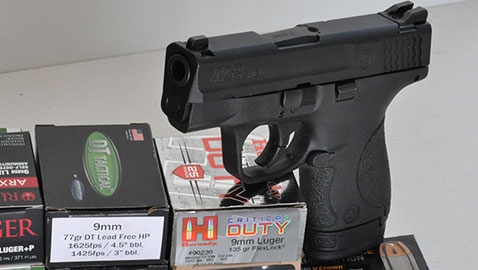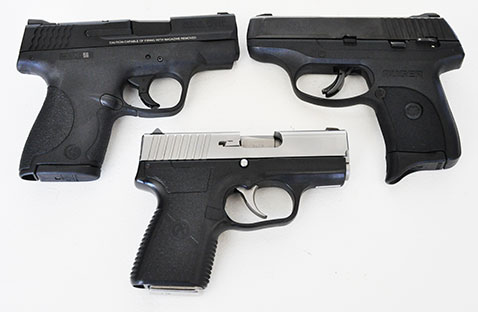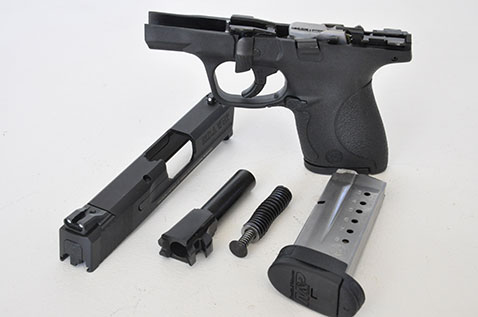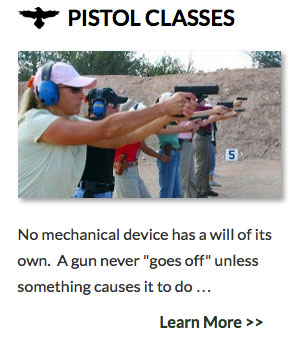Widgetized Section
Go to Admin » Appearance » Widgets » and move Gabfire Widget: Social into that MastheadOverlay zone
Reviewing The Smith & Wesson Shield 9mm

When Smith & Wesson announced their Shield .45ACP pistol earlier this year I asked them to send me a Shield 9mm as well. The 9mm Shield has been around for several years and has been a very successful seller in the red-hot concealed carry market. We’re going to take a look at the 9mm first and in a subsequent article we’ll evaluate the .45 while comparing it to the 9mm.
The Shield lineup of pistols are an outgrowth of Smith & Wesson’s very popular M&P (Military & Police) line. These include full size and compact models in 9mm, .40 S&W and .45ACP, as well as various models with and without thumb safeties, night sights, optic ready and ported barrel versions. The Shield versions of the M&P pistols can be seen as the sub-compact pistols in the lineup and, like the other models, share the same chamberings and many of the same options. While some folks may see the Shields as pocket pistols I think they more appropriately fill the role of small, easily concealable pistols best carried in a belt or inside the waistband holster or in a lady’s bag. Attributes like their small, thin profile, reliability and ease of operation are appealing features of Shield pistols.

S&W Shield compared to the Ruger LC9s (Top Right) and Kahr PM9 (Bottom)
The Shield 9mm isn’t the smallest 9mm designed for concealed carry nor is it the largest; it falls into that category of being “just right”. You see, if the pistol is large it’s easier to shoot but harder to conceal but if it’s small it’s easy to conceal and hard to shoot. What’s needed is a bit of balance and I think the Shield achieves this very well. Weighing 18.2 ounces bare, that is unloaded and with no magazine, the Shield comes in at a carry weight of 23.6 ounces with a loaded magazine and a round in the chamber, for a total of eight rounds on board. Putting that in perspective, the Shield, all up, weighs several ounces less than an unloaded Colt Lightweight Commander 1911 and is about an ounce heavier than a fully loaded Ruger LC9s. With a good holster carrying a pistol in this weight range is no burden. The Shield comes with two magazines; the standard magazine holds 7 rounds and fits flush with the bottom of the magazine well. The other magazine holds one extra round and has an extended baseplate that allows a place for the pinky to perch when shooting the pistol. One magazine is slightly easier to conceal and the other makes shooting a bit easier, so take your pick. Both magazines are difficult to load without a magazine loader but I found they loosened up a bit with use.

Field stripped S&W Shield 9mm
If you’re familiar with any of the M&P pistols you’re good to go when field stripping the Shield for cleaning. The pistol is designed for easy, safe – big emphasis on safe – disassembly. After removing the magazine and locking the slide to the rear by retracting it while pushing up on the slide lock, physically and visually ensure the pistol is unloaded and there is no round in the chamber. Looking down through the ejection port you’ll see a small, yellow colored piece of metal that looks like a crooked pin. Smith & Wesson call this a sear deactivation lever. It serves to unlock the action and allow disassembly so you can call it a disassembly lever if you wish. The lever needs to be pushed down so it pivots into position protruding into the magazine well. I’ve found the ideal tool for pivoting the lever is a ballpoint pen with the point retracted. Once the lever is in the down position the takedown lever on the left side of the frame is rotated down and this allows the slide lock to be released and the slide to be removed forward off the frame. Lifting the captive recoil spring up from the rear and removing the barrel in the same way completes disassembly for cleaning and lubricating. As usual, reassembly is performed by reversing the process, but with a small exception. It’s not necessary to attempt returning the takedown lever up into it’s stowed position. Simply inserting an unloaded magazine into the magazine well accomplishes the task.
I’ve found, with small pistols, there are a couple of things that have the most profound effect on my ability to shoot them well. The sights are important and my sample Shield came with a very serviceable set of sights in the ubiquitous three white dot pattern. Thin pistols like the Shield may wiggle around in my hand a bit when shooting, especially if the trigger is difficult to manage. Fortunately, the trigger on my sample is usable although gritty and crunchy feeling, breaking at an average of about 7.5 pounds with no over-travel (movement of the trigger after it “breaks”). Comparing the two Shields I have on hand, the trigger of the .45 breaks crisply at just over 6 pounds and is a much better trigger than the one in the 9mm without the crunchy feel. An observation: I’ve handled and shot a lot of M&P pistols and the triggers have varied considerably in quality. Some have been very good while others were almost unusable. My advice if you’re looking to buy an M&P or Shield is to wander down to your friendly gun emporium and try the triggers on as many of the model you’re looking to buy as the dealer has on hand then select the one with the trigger that best suits you.
At the range I ran about a dozen different 9mm loads through the Shield. Most of the ammo I have on hand is high quality defensive ammunition running from standard velocity and pressure up to +P and it all ran without a hitch. Obviously, there is sharper recoil and more muzzle flip with the hotter ammunition but I was able to fire it all without discomfort. I have some +P+ 9mm defensive ammunition but I didn’t use it for this test as the instruction manual cautions against using it in the Shield. While I have little doubt the pistol can handle it, there’s no point in shooting very high pressure ammunition in such a small pistol as there is little benefit and a lot more flash, recoil and muzzle flip to contend with. Shooting through the Gunsite 250 School Drill and various defensive shooting drills proved that the Shield is more than suitable for its role as a concealed carry defensive pistol. With a street price of around $400 its little wonder the Shield has become a runaway best seller for Smith & Wesson.
About the Author:
 Ed Head is a regular on Shooting Gallery, Gun Stories and Down Range TV. He has worked for almost 30 years in law enforcement, first in the United States Air Force and then with the United States Border Patrol, retiring as a Field Operations Supervisor. During his Border Patrol career, Ed worked in a variety of patrol, investigative and training capacities. Ed has an extensive background as a firearms instructor, having trained thousands, ranging from beginners to police, military and special operations personnel. Having taught at Gunsite for 20 years, Ed first trained there under the world famous shooting school’s founder, Jeff Cooper, then later ran the school as the operations manager for more than five years. Ed lives in Chino Valley, Arizona, where he continues to teach and write.
Ed Head is a regular on Shooting Gallery, Gun Stories and Down Range TV. He has worked for almost 30 years in law enforcement, first in the United States Air Force and then with the United States Border Patrol, retiring as a Field Operations Supervisor. During his Border Patrol career, Ed worked in a variety of patrol, investigative and training capacities. Ed has an extensive background as a firearms instructor, having trained thousands, ranging from beginners to police, military and special operations personnel. Having taught at Gunsite for 20 years, Ed first trained there under the world famous shooting school’s founder, Jeff Cooper, then later ran the school as the operations manager for more than five years. Ed lives in Chino Valley, Arizona, where he continues to teach and write.



 MidwayUSA
MidwayUSA Ruger Firearms
Ruger Firearms SCCY Firearms
SCCY Firearms Streamlight
Streamlight Action Targets
Action Targets Gunsite Academy
Gunsite Academy
You must be logged in to post a comment Login